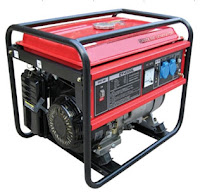Stand By - Standby generators provide backup power in homes and offices and are permanently installed outside your home or office building. They are located in the electric circuits or home wiring. - The unit automatically turns itself on and off. They can automatically detect disruption of normal power and initiated within a fe w seconds. - Propane and natural gas provides a safe and long-term supply of fuel and is more environmentally friendly than petrol or diesel. - Like any engine, a generator motor creates a lot of heat and needs a cooling system to prevent overheating. Standby generators can be cooled by air or water cooled. The biggest difference is that air cooled systems are louder and not as effective. Liquid-cooled systems are quieter and more reliable - and also more expensive to buy and maintain.
w seconds. - Propane and natural gas provides a safe and long-term supply of fuel and is more environmentally friendly than petrol or diesel. - Like any engine, a generator motor creates a lot of heat and needs a cooling system to prevent overheating. Standby generators can be cooled by air or water cooled. The biggest difference is that air cooled systems are louder and not as effective. Liquid-cooled systems are quieter and more reliable - and also more expensive to buy and maintain.
Portable - Portable generators are commonly used in places where no power supply, such as construction sites, camps, etc. These generators are sufficient to run appliances like TV, refrigerators, furnaces and sump pumps. - Portable systems are wheeled units that need to roll the generator outside, start it and connect it to a cable box Portable generators supply electricity to selected appliances through extension cords. - They are powered by gasoline, which can be difficult to store and transport during a blackout. Carbon monoxide is always a concern in the safe use of portable generators. - They are designed to be used in a short period of only a few hours in a row. As a result, they seem to be much smaller and cheaper.
A related aspect of the generator engine is how fast they run, measured in revolutions. Generators made for the U.S. market to operate in one of two speeds: 1800 RPM or 3600 RPM. 1800 rpm engine last longer and run quieter; 3600 rpm motors are smaller and lighter.





